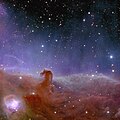File:Euclid’s view of the Horsehead Nebula ESA25170866.tiff
頁面內容不支援其他語言。
外觀

此 TIF 檔案的 PNG 預覽的大小:600 × 600 像素。 其他解析度:240 × 240 像素 | 480 × 480 像素 | 768 × 768 像素 | 1,024 × 1,024 像素 | 2,048 × 2,048 像素 | 8,200 × 8,200 像素。
原始檔案 (8,200 × 8,200 像素,檔案大小:256.71 MB,MIME 類型:image/tiff)
摘要
| 警告 | 部分瀏覽器在瀏覽此圖片的完整大小時可能會遇到困難:該圖片中有數量巨大的像素點,可能無法完全載入或者導致您的瀏覽器停止回應。 | 交互式大图查看器 |
|---|
| 描述Euclid’s view of the Horsehead Nebula ESA25170866.tiff |
English: Euclid shows us a spectacularly panoramic and detailed view of the Horsehead Nebula, also known as Barnard 33 and part of the constellation Orion. At approximately 1375 light-years away, the Horsehead – visible as a dark cloud shaped like a horse’s head – is the closest giant star-forming region to Earth. It sits just to the south of star Alnitak, the easternmost of Orion’s famous three-star belt, and is part of the vast Orion molecular cloud. Many other telescopes have taken images of the Horsehead Nebula, but none of them are able to create such a sharp and wide view as Euclid can with just one observation. Euclid captured this image of the Horsehead in about one hour, which showcases the mission's ability to very quickly image an unprecedented area of the sky in high detail. Read more about Euclid’s view of the Horsehead Nebula Explore this image at the highest resolution in ESASky Read more about Euclid's first images [Technical details: The data in this image were taken in just five hours of observation. This colour image was obtained by combining VIS data and NISP photometry in Y and H bands; its size is 8800 x 8800 pixels. VIS and NISP enable observing astronomical sources in four different wavelength ranges. Aesthetics choices led to the selection of three out of these four bands to be cast onto the traditional Red-Green-Blue colour channels used to represent images on our digital screens (RGB). The blue, green, red channels capture the Universe seen by Euclid around the wavelength 0.7, 1.1, and 1.7 micron respectively. This gives Euclid a distinctive colour palette: hot stars have a white-blue hue, excited hydrogen gas appears in the blue channel, and regions rich in dust and molecular gas have a clear red hue. Distant redshifted background galaxies appear very red. In the image, the stars have six prominent spikes due to how light interacts with the optical system of the telescope in the process of diffraction. Another signature of Euclid special optics is the presence of a few, very faint and small round regions of a fuzzy blue colour. These are normal artefacts of complex optical systems, so-called ‘optical ghost’; easily identifiable during data analysis, they do not cause any problem for the science goals. ] [Image description: This square astronomical image is divided horizontally by a waving line between a white-orange cloudscape forming a nebula along the bottom portion and a comparatively blue-purple-pink upper portion. From the nebula in the bottom half of the image, an orange cloud shaped like a horsehead sticks out. In the bottom left of the image, a white round glow is visible. The clouds from the bottom half of the image shine purple/blue light into the upper half. The top of the image shows the black expanse of space. Speckled across both portions is a starfield, showing stars of varying sizes and colours. Blue stars are younger and red stars are older.] |
| 日期 | 2023年十一月7日 (上傳日期) |
| 來源 | Euclid’s view of the Horsehead Nebula |
| 作者 | ESA/Euclid/Euclid Consortium/NASA image processing by J.-C. Cuillandre (CEA Paris-Saclay) G. Anselmi |
| 其他版本 |
|
| Activity InfoField | Space Science |
| Keyword InfoField | Horsehead Nebula Stars |
| Mission InfoField | Euclid |
| Set InfoField | Euclid First Images |
授權條款
This media was created by the European Space Agency (ESA).
Where expressly so stated, images or videos are covered by the Creative Commons Attribution-ShareAlike 3.0 IGO (CC BY-SA 3.0 IGO) licence, ESA being an Intergovernmental Organisation (IGO), as defined by the CC BY-SA 3.0 IGO licence. The user is allowed under the terms and conditions of the CC BY-SA 3.0 IGO license to Reproduce, Distribute and Publicly Perform the ESA images and videos released under CC BY-SA 3.0 IGO licence and the Adaptations thereof, without further explicit permission being necessary, for as long as the user complies with the conditions and restrictions set forth in the CC BY-SA 3.0 IGO licence, these including that:
See the ESA Creative Commons copyright notice for complete information, and this article for additional details.
|
 | |
此檔案採用創用CC 姓名標示-相同方式分享 3.0 國際政府組織授權條款。 姓名標示: ESA/Euclid/Euclid Consortium/NASA, image processing by J.-C. Cuillandre (CEA Paris-Saclay), G. Anselmi, CC BY-SA IGO 3.0
| ||
說明
添加單行說明來描述出檔案所代表的內容
Euclid shows us a spectacularly panoramic and detailed view of the Horsehead Nebula, also known as Barnard 33 and part of the constellation Orion.
創用CC姓名標示3.0國際政府組織 繁體中文 (已轉換拼寫)
多媒體型式 繁體中文 (已轉換拼寫)
image/tiff
8,200 像素
8,200 像素
資料大小 Chinese (Hong Kong) (已轉換拼寫)
269,178,138 位元組
7 11 2023
檔案來源 Chinese (Taiwan) (已轉換拼寫)
5qzzm1m9mn5rm520v14aspmbwwhh7yatw0ymjfmtzt8nzodmc8
檔案歷史
點選日期/時間以檢視該時間的檔案版本。
| 日期/時間 | 縮圖 | 尺寸 | 用戶 | 備註 | |
|---|---|---|---|---|---|
| 目前 | 2023年11月7日 (二) 18:51 |  | 8,200 × 8,200(256.71 MB) | OptimusPrimeBot | #Spacemedia - Upload of https://esamultimedia.esa.int/img/2023/11/Euclid-ERO-Horsehead.8K8K.tif via Commons:Spacemedia |
檔案用途
下列頁面有用到此檔案:
全域檔案使用狀況
以下其他 wiki 使用了這個檔案:
- en.wikipedia.org 的使用狀況
- fa.wikipedia.org 的使用狀況
- ko.wikipedia.org 的使用狀況
詮釋資料
此檔案中包含擴展的資訊。這些資訊可能是由數位相機或掃描器在建立時或數位化過程中所加入。
如果此檔案的來源檔案已被修改,一些資訊在修改後的檔案中將不能完全反映出來。
| 影像標題 | {"shape": [8200, 8200, 3]} |
|---|---|
| 使用者評論 | {"shape": [8200, 8200, 3]} |
| 寬度 | 8,200 px |
| 高度 | 8,200 px |
| 壓縮方式 | 未壓縮 |
| 像素合成 | RGB |
| 方位 | 標準 |
| 像素數量 | 4 |
| 每帶行數 | 128 |
| 水平解析度 | 1 dpi |
| 垂直解析度 | 1 dpi |
| 資料排列 | 矮胖格式 |
| 使用軟體 | GIMP 2.10.18 |
| 檔案修改日期時間 | 2023年10月29日 (日) 09:54 |
| 色彩空間 | sRGB |




